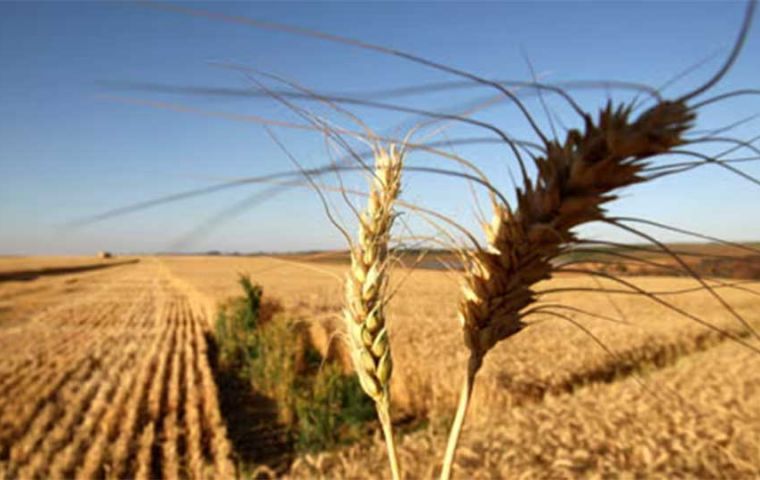MercoPress. South Atlantic News Agency
Brazil needs to purchase 3,5 million tons of wheat, despite higher yields in domestic production, says CEPEA
 Argentina is Brazil’s largest wheat supplier, and the President Milei government has reduced export taxes which should help sales to its Mercosur partner
Argentina is Brazil’s largest wheat supplier, and the President Milei government has reduced export taxes which should help sales to its Mercosur partner Wheat production 2024/2025 in Brazil fell by 2.6% compared to the previous year, with the National Supply Company (Conab) forecasting a harvest of 7.89 million tons in 2024. This also represents an 11.9% reduction in the cultivated area, which shrank to 3.06 million hectares.
However, yields increased by 10.6%, reaching 2.58 tons per hectare, partially offsetting the loss of sown land. The information is from the January report of the Center for Advanced Studies in Applied Economics (CEPEA – ESALQ USP).
With this reduction in domestic supply, Brazil will continue to rely on imports to meet internal demand, which is expected to reach 11.9 million tons. Even considering initial stocks, the forecast is that the domestic deficit will be around 3,5 million tons, keeping the market active and attracting foreign purchases.
Argentina, Brazil’s largest wheat exporter, may ease external supply as the Argentine government has reduced export taxes from 12% to 9.5% until June 30. However, competition with other countries will be more intense due to increased wheat Chinese purchases from Argentina, a movement not seen since the 1990s, according to the CEPEA report.
Globally China is expected to become the world’s fourth-largest wheat importer, with an estimated 10.5 million tons, according to the United States Department of Agriculture (USDA). Additionally, U.S. export policies may change under Donald Trump’s administration, potentially affecting international trade.
Among the ten countries are the leading suppliers of wheat for Brazil, Argentina, 68%; Uruguay, 11,8%: Russian Federation, 10%: USA, 5.5%: Chile, 2,1%: Ecuador, 1.3%: Canada, 1,1% and other origins, 0,8%.
Globally Argentina’s wheat harvest is expected to reach 18.6 million tons, a 23% increase compared to the 2023/24 cycle. Worldwide, the USDA projects total wheat production of 793.2 million tons for the 2024/25 season, reflecting a slight 0.3% increase over the previous year.
However, some major producers, including Russia, the European Union, Turkey, and Ukraine, are expected to face production declines of 10.9%, 10.2%, 9.5%, and 0.4%, respectively. This could result in a tighter global supply and increased pressure on prices.
Global consumption is also projected to rise, albeit modestly, by 0.5%, reaching 801.9 million tons. As a result, final wheat stocks are expected to fall by 3.2%, to 258.8 million tons—the lowest level since the 2015/16 season. This scenario could reduce the global stock-to-use ratio to 32.4%, impacting international market dynamics. Furthermore, the global wheat trade is expected to hit its lowest volume since the 2021/22 season, totaling 212.3 million tons.
This means international prices are expected to remain under pressure, particularly among the largest exporters: USA, Canada, Australia, Argentina, and Kazakhstan. However, imports will be more evenly distributed among various countries. This dynamic may influence flour prices in Brazil, which are expected to rise, especially in the first quarter of 2025, due to the impact of external purchases and import foreign exchange parity.
However Globo Rural points out the disparity among wheat farmers in Brazil, even when operational costs have not risen as sharply as wheat prices, with interesting margins of profits for the more efficient, particularly with wheat sales prices in local currency, recording significant increases of between 30% and 34% compared to the previous year.
For example, in Rio Grande do Sul, operational costs rose by 8.5%; In Xanxerê (Santa Catarina), the increase was 5.5%. In regions like western Paraná and Guarapuava, cost increases were milder at 2% and 0.7%, respectively. However, the impact on cost-benefit varied: in Xanxerê, for example, revenue remained below costs, while in other regions, net income was positive, with rates ranging from 15% to 25%. Nevertheless the crop faces climatic challenges, particularly in the South and Southeast regions, which could limit investments and production, according to CEPEA.




Top Comments
Disclaimer & comment rulesCommenting for this story is now closed.
If you have a Facebook account, become a fan and comment on our Facebook Page!